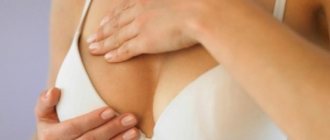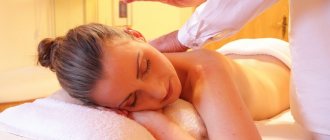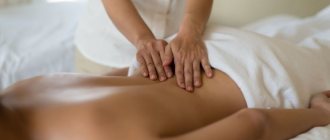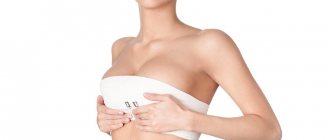Breastfeeding is a natural biological process, but for various reasons it can be disrupted, which provokes various pathologies of the mammary glands. The most common phenomenon is lactostasis, which occurs due to stagnation of breast milk in the ducts. If the situation is not advanced, then you can cope with this problem yourself, including using massage for lactostasis. It is only important to do it correctly so as not to aggravate the problem and create favorable conditions for the development of infectious foci and inflammation.
Causes and symptoms of milk stagnation
In most cases, stagnation of milk in the breast occurs due to violation of the rules of breastfeeding. Lactostasis can occur against the background of:
- not putting the baby to the breast often enough,
- incomplete emptying of the breast,
- uncomfortable position of the baby and woman at the time of feeding,
- improper grasping of the nipple by the baby's mouth,
- too thick, fatty milk,
- uncomfortable underwear for the breasts (tight bra, presence of underwires, dense cups),
- woman's habit of sleeping on her stomach,
- hormonal imbalances in the body,
- mammary gland injuries,
- stressful situations,
- overwork.
Learn about the functions of vasopressin in the body, as well as the norm and causes of deviations.
Read about the symptoms of follicular thyroid cancer in women, as well as about the treatment of cancer at this address.
When the ducts are clogged with milk and it stagnates, a woman experiences certain symptoms:
- breast swelling,
- soreness,
- seals,
- skin hyperemia.
With more severe lactostasis, the temperature rises, chills and weakness appear.
Causes of lactostasis
Irregular expression of milk residues after feeding leads to lactostasis
There are two types of nutrient fluid in the mammary gland of women. The first milk that appears from the ducts is not fatty, more like water. It is necessary for the baby to quench his thirst. What is located further in the ducts is fattier and more nutritious. It satisfies the child's food needs.
Some women feed their baby in such a way that they give him a little milk from each breast so that he sucks it evenly. This leads to the fact that the fatty component of milk passes through the ducts with difficulty, creating the preconditions for lactostasis. At the same time, the child does not eat enough and remains hungry.

When feeding only one breast, milk stagnation may form in the other mammary gland.
Other reasons:
- Irregular pumping. A woman's fatigue forces her to rest more during the postpartum period. Sometimes she simply forgets to express the other breast and goes to bed. By morning, stagnation of milk has already formed in the mammary gland of the nursing mother.
- During sleep, it is possible that any lobe may be compressed, as a result of which the components of the milk also become compacted and a dense plug appears.
- By fully expressing both breasts, a woman stimulates an even greater milk supply. The body perceives this as a need to produce even more nutrition, because the child does not have enough of it. Excess can have a bad effect on the condition of the mammary gland, since the baby is not able to eat as much.
- When feeding on one side, the milk ducts develop and become elastic. In the other breast, which does not participate in feeding, congestion may form.
- A woman drinks little water, which leads to the formation of very fatty and viscous milk, which sticks to the walls of the ducts, forming an impassable area.
- When introducing complementary foods, part of the nutrient fluid remains unspent and therefore remains in the ducts. This happens at later stages of lactation and is not so dangerous.
Some mothers have had breast surgery in the past to remove benign tumors. Any surgical intervention causes tissue scarring. The process can affect the ducts and lead to their obstruction. In such a situation, lactostasis begins as soon as the milk begins to arrive. The help of surgeons may be needed, since a blocked duct is a dangerous phenomenon during lactation.
The benefits of massage for lactostasis
Breast massage is considered one of the most effective methods for eliminating milk stagnation during lactation. Its benefits are as follows:
- stimulates the synthesis of oxytocin, the hormone responsible for milk production,
- relieves pain, relieves muscle tension,
- softens lumps, promotes emptying of milk ducts,
- improves blood circulation, enhancing lactation.
On a note! If you perform the massage correctly, then after just a few days you can get rid of the symptoms of lactostasis, relieve pain, and normalize the functioning of the mammary glands.
Recommendations for nursing mothers
- It is necessary to understand the cause of lactostasis and eliminate it.
- If there is stagnation, then there is no need to try to strain it immediately after feeding the baby. The brain perceives this action as a signal that the baby does not have enough milk, and secretion by the mammary glands increases, and lactostasis progresses.
- To reduce lactation, limit the amount of liquid you drink and exclude warm drinks from your diet.
- Camphor-alcohol compresses can cause milk burnout and stop the lactation process.
- Any treatment method will be more effective if it is accompanied by a diet. Fatty, spicy, hot, rich foods are excluded from the diet. The use of beets and prunes is recommended.
- A fresh cabbage leaf compress on the painful area may help. The vegetable is washed, a leaf is separated from it, pricked with a knife until droplets of juice appear and placed under a bra for a period of 3 hours.
It is important to know! Lactostasis in the mother does not affect the child’s body. To alleviate a woman’s condition, the baby is applied to the sore mammary gland as often as possible. Active sucking expands the ducts and eliminates congestion.
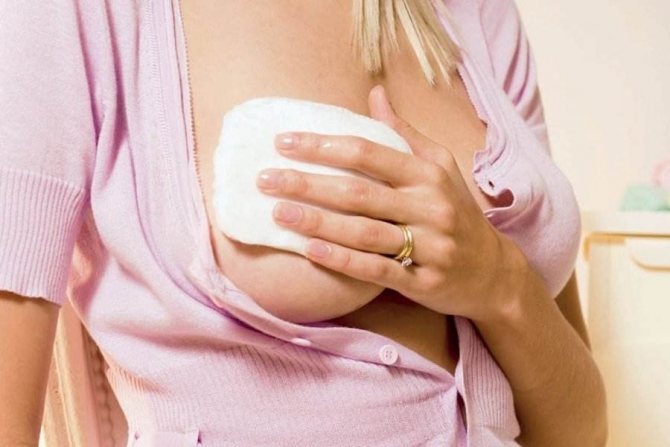
Read also:
Causes of cracked nipples during breastfeeding
Rules of procedure
For the procedure to be effective, it must follow certain rules:
- Massage before feeding your baby or before pumping.
- Movements during the massage should be careful and smooth. Aggressive, intense movements can harm the glands.
- Use a rich cream or neutral oil during the procedure to avoid skin injury.
- Follow the direction from the edge of the breast to the nipple.
- The massage should cover the entire mammary gland and armpits.
- For severe chest pain, massage can be performed in a warm bath (37°C), which helps to relax the muscles.
Execution technique
The massage consists of several stages:
- stroking,
- spirals,
- tapping,
- shaking.
You must first wash your hands and lubricate them with cream or cosmetic oil.
Using light spiral movements, knead each section of the chest step by step. Pay special attention to compaction areas. Massage from the side up, then towards the center, down and again to the side. All movements should be directed from the periphery to the center. This technique helps warm up the breasts and promotes the release of milk from the ducts.
Using stroking movements, knead each lobe of the gland. In stagnant areas, stop longer. After this, very carefully tap the surface of the chest with your fingertips, lightly pressing on it. Finally, lean forward and lightly shake your chest.
Learn about the treatment of adrenal gland diseases in men and women using traditional medicine.
The symptoms of increased ionized calcium in the body and the symptoms of abnormalities are written on this page.Go to https://fr-dc.ru/zabolevaniya/diagnostika/trepanobiopsy.html and read about how trepanobiopsy of the breast is performed and what the results of the diagnostic examination show.
What happens when you massage the breast and what is this disease?
Like any other form of massage, kneading the chest always leads to a powerful flow of blood to the affected organs. When carrying out this procedure, the temperature in the massaged area always rises.
The parts of the body that are being kneaded, be it the chest or the back, always become warm and even hot, again due to the influx of a large amount of blood.
As a result, massage significantly enhances almost all processes occurring in the kneaded organs.
Naturally, physiological or pathological processes in the breast can also progress significantly after massaging. And if the problem was the presence of purulent inflammation, it will only progress, reaching its most dangerous forms.
Mastitis is almost always an acute inflammatory infectious process occurring in the mammary gland. Directly with mastitis, the infection (a specific pathogen) penetrates the tissues of the mammary gland, and suppuration forms there.
The very first manifestation of mastitis is often the appearance of dangerous cracks on a woman's nipples. If such cracks are not treated, after a few days a woman may experience an inflammatory process with pain in the chest. Often, with mastitis:
- A woman’s mammary glands swell greatly, they can become dense and increase in size.
- The skin affected by mastitis of the mammary glands may become red, since under such redness there is usually a specific infiltrate.
- With this disease, severe chills may appear and even the body temperature may rise, up to the highest numbers.
The video usually clearly shows how poorly patients with mastitis feel. Breast disease is visible even to the naked eye. Sometimes, women's breasts increase to catastrophic sizes, and cause significant discomfort and pain.
If the inflammatory process is severely started by the woman herself (who, say, did not want to see a doctor in a timely manner), severe suppuration occurs, which ultimately leads to the need for surgery.
Expressing milk after a massage
It is advisable to put the baby to the breast after the procedure. If this is not possible, then you need to express the milk. Otherwise, stagnation may happen again.
You can express milk using a breast pump or manually. But you need to do this correctly:
- first make a warm compress for the chest,
- wrap your arms around her at the top and bottom,
- Place the thumb and index finger of the hand below on the nipple,
- make light massage movements, heading towards the areola.
You need to pump several times a day. The procedure is not necessary if the child himself drinks a sufficient amount of milk and empties the breast.
What to do with lactostasis
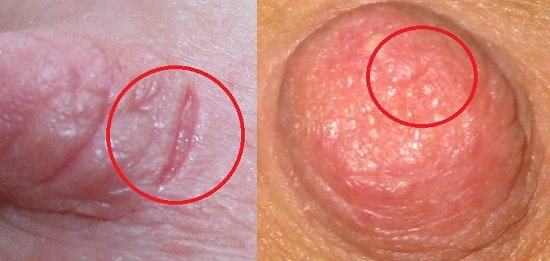
If cracks appear, the nipples must be treated with a special ointment.
The first thing to do if milk stagnation has formed in the mammary glands is to examine the nipple for microcracks. An infection can get through them and this will greatly complicate the situation. It is better to use the ointment right away - it should be in the arsenal of every nursing mother. Next, you need to prepare to knead and express the mammary gland for a long time so that the plug dissolves and all the milk comes out. This can take time and effort, as pumping must be done carefully and with gentle movements.
It is possible and even necessary to feed a baby with lactostasis. Only he will be able to grab the nipple correctly and push the plug to the exit. There are several positions in which it is recommended to attach the baby to the breast. The principle is that the baby’s lower lip should be closer to the place of stagnation, since it is it that produces the sucking movements and captures the areola more:
- If the congestion is closer to the armpit, the child is placed from under the arm with his head towards the other breast.
- If below - from under the arm with the head in the forward direction.
If your baby has difficulty latching on to the nipple, you may need to express a little milk to make the areola soft.
Massage
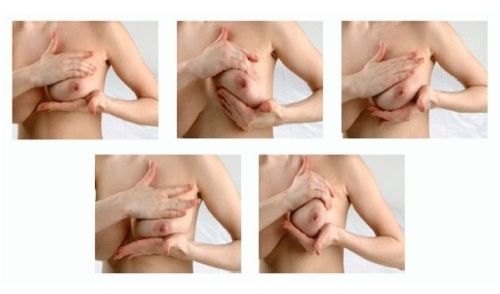
Breast massage gives good results when pumping stagnant milk
The massage is carried out simultaneously with pumping, alternately kneading the nipple and pushing milk from the armpit area to the outlet. It can take some time. The lobe in the mammary gland where congestion has formed is massaged longer. Different techniques can be used:
- circular movements;
- longitudinal stroking.
Periodically you need to feel with both hands how effectively the seal is dissolving. To do this, hands are placed on both sides: bottom/top and sides. If the breasts are soft and the pain is gone, then lactostasis has been eliminated.
Just in case, before the next feeding, you need to check the place where the plug was to make sure that the massage was successfully carried out.
You can massage the mammary glands during stagnation of milk by first applying vegetable oil to the skin so that the movements are gliding.
Pumping
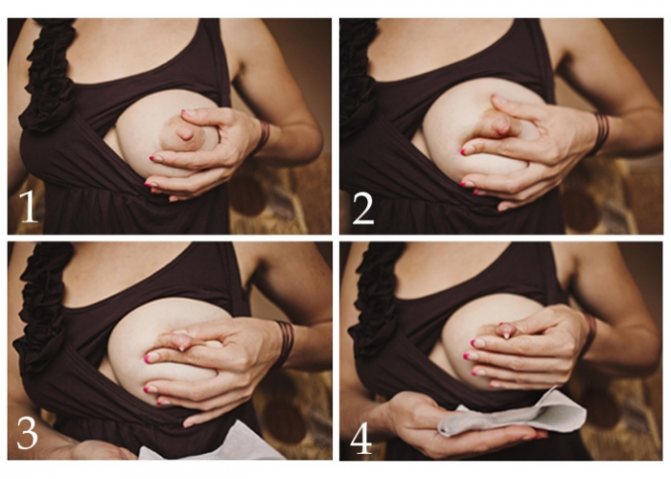
The process of manually expressing breast milk step by step
By pumping you can regulate the amount of milk. The more and more often you pump, the more it will be produced and vice versa.
If it is not possible to devote a lot of time to pumping, to reduce the risk of lactostasis, it is enough to remove only a third of the milk. In this case, less of it will arrive, and a traffic jam will not occur.
For some women, stagnation occurs at the end of lactation, when the baby no longer needs breast milk. Many people advise taking some kind of medication so that milk stops being produced, some advise bandaging the breasts.
You can end lactation in a simple way by expressing a little milk so that your breasts don’t hurt. Eventually it will stop coming.
Compresses

You can use raw potatoes as a compress.
Compresses made from cabbage leaves or fresh burdock will help reduce inflammation. You can smear your chest with honey, and then apply a sheet broken with a rolling pin.
Other recipes:
- Flatbread made from honey and rye flour.
- Raw potatoes, grated on a coarse grater.
Curd compresses with honey help reduce local temperature. You can take a warm or hot shower. This expands the ducts and helps them free from the milk plug.
Physical exercise
Accelerating the movement of lymph through the vessels will help eliminate stagnation. To do this, you can take a twenty-minute walk in the fresh air. Movements of the upper limbs in different directions - in a circle, from bottom to top - also accelerate blood flow and expand the milk ducts. If the pain is severe, the exercises are carried out simultaneously with massage and pumping. Before the procedure, you can take a painkiller - preferably no-shpu.
Medicines and dietary supplements

The best supplement to take is spirulina.
You can take medications in case of severe pain so that you can have a massage. For this purpose, antispasmodics are used that dilate blood vessels.
If the doctor recommends antibiotics, they are taken in case of mastitis. It is necessary to clarify whether antibacterial agents are really needed in this situation, because breastfeeding will have to be interrupted.
The best supplement to take is spirulina. It has a minimum of contraindications, and also relieves inflammation and strengthens the immune system.
Physiotherapeutic procedures
They are carried out in a hospital if a woman is unable to eliminate lactostasis on her own. Blockage of the mammary gland duct during feeding is eliminated using physiotherapy:
- ultrasound;
- UHF;
- electrophoresis;
- magnetic therapy.
The devices widen the ducts and facilitate the passage of milk.



